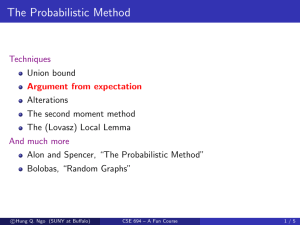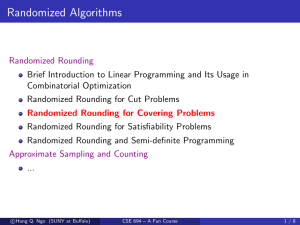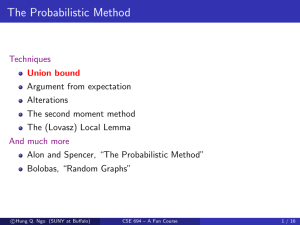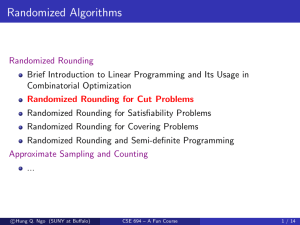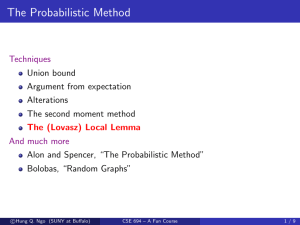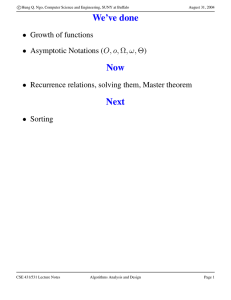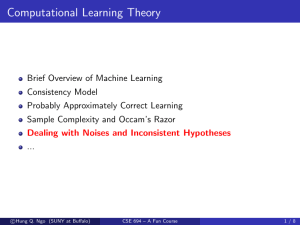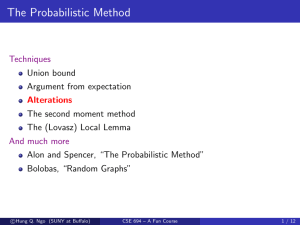Document 10555119
advertisement
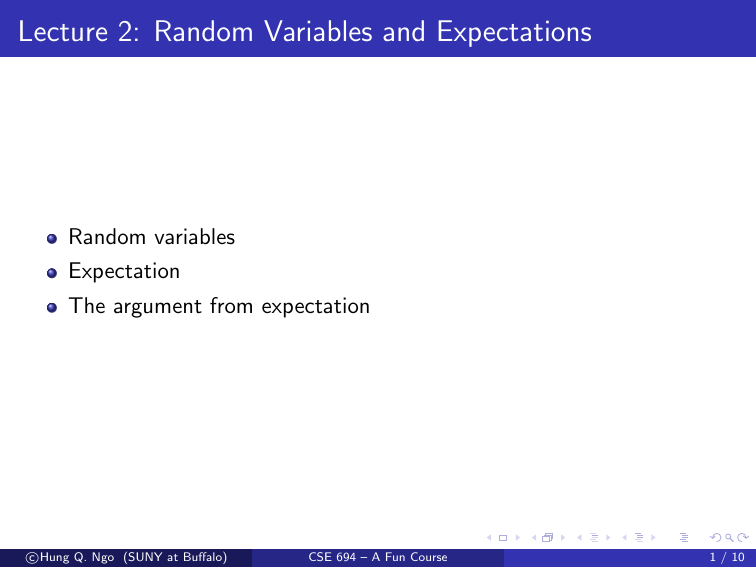
Lecture 2: Random Variables and Expectations
Random variables
Expectation
The argument from expectation
c
Hung
Q. Ngo (SUNY at Buffalo)
CSE 694 – A Fun Course
1 / 10
PTCF: Discrete Random Variable
Event X = a is {ω | X(ω) = a}
X(ω) 6= a
a
a
X(ω) 6= a
a
a
A random variable is a function X : Ω → R
pX (a) = Prob[X = a] is called the probability mass function of X
PX (a) = Prob[X ≤ a] is called the (cumulative/probability)
distribution function of X
c
Hung
Q. Ngo (SUNY at Buffalo)
CSE 694 – A Fun Course
2 / 10
PTCF: Expectation and its Linearity
The expected value of X is defined as
X
E[X] :=
a Prob[X = a].
a
For any set X1 , . . . , Xn of random variables, and any constants
c1 , . . . , cn
E[c1 X1 + · · · + cn Xn ] = c1 E[X1 ] + · · · + cn E[Xn ]
This fact is called linearity of expectation
c
Hung
Q. Ngo (SUNY at Buffalo)
CSE 694 – A Fun Course
3 / 10
PTCF: Indicator/Bernoulli Random Variable
X : Ω → {0, 1}
p = Prob[X = 1]
X is called a Bernoulli random variable with parameter p
If X = 1 only for outcomes ω belonging to some event A, then X is called
an indicator variable for A
E[X] = p
Var [X] = p(1 − p)
c
Hung
Q. Ngo (SUNY at Buffalo)
CSE 694 – A Fun Course
4 / 10
The Argument from Expectation: Main Idea
X a random variable with E[X] = µ, then
There must exist a sample point ω with X(ω) ≥ µ
There must exist a sample point ω with X(ω) ≤ µ
X a random variable with E[X] ≤ µ, then
There must exist a sample point ω with X(ω) ≤ µ
X a random variable with E[X] ≥ µ, then
There must exist a sample point ω with X(ω) ≥ µ
c
Hung
Q. Ngo (SUNY at Buffalo)
CSE 694 – A Fun Course
5 / 10
Example 1: Large Cuts in Graphs
Intuition & Question
Intuition: every graph must have a “sufficiently large” cut (A, B).
Question: How large?
Line of thought
On average, a random cut has size µ, hence there must exist a cut of size
≥ µ.
Put a vertex in either A or B with probability 1/2
Expected number of edges X with one end point in each is
"
#
X
X
E[X] = E
Xe =
Prob[Xe ] = |E|/2
e
e
Theorem
For every graph G = (V, E), there must be a cut with ≥ |E|/2 edges
c
Hung
Q. Ngo (SUNY at Buffalo)
CSE 694 – A Fun Course
6 / 10
Example 2: ±1 Linear Combinations of Unit Vectors
Theorem
Let v1 , · · · , vn be n unit vectors in Rn .
There exist α1 , · · · , αn ∈ {−1, 1} such that
|α1 v1 + · · · + αn vn | ≤
√
n
and, there exist α1 , · · · , αn ∈ {−1, 1} such that
√
|α1 v1 + · · · + αn vn | ≥ n
Specifically, choose αi ∈ {−1, 1} independently with prob. 1/2
X
X
E |α1 v1 + · · · + αn vn |2 =
vi · vj E[αi αj ] =
vi2 = n.
i,j
c
Hung
Q. Ngo (SUNY at Buffalo)
CSE 694 – A Fun Course
i
7 / 10
Example 3: Max-E3SAT
An E3-CNF formula is a CNF formula ϕ in which each clause has
exactly 3 literals. E.g.,
ϕ = (x1 ∨ x̄2 ∨ x4 ) ∧ (x1 ∨ x3 ∨ x̄4 ) ∧ (x̄2 ∨ x̄3 ∨ x4 )
|
{z
} |
{z
} |
{z
}
Clause 1
Clause 2
Clause 3
Max-E3SAT Problem: given an E3-CNF formula ϕ, find a truth
assignment satisfying as many clauses as possible
A Randomized Approximation Algorithm for Max-E3SAT
Assign each variable to true/false with probability 1/2
c
Hung
Q. Ngo (SUNY at Buffalo)
CSE 694 – A Fun Course
8 / 10
Analyzing the Randomized Approximation Algorithm
Let XC be the random variable indicating if clause C is satisfied
Then, Prob[XC = 1] = 7/8
Let Sϕ be the number of satisfied clauses. Then,
"
#
X
X
opt
E[Sϕ ] = E
XC =
E[XC ] = 7m/8 ≥
8/7
C
C
(m is the number of clauses)
So this is a randomized approximation algorithm with ratio 8/7
c
Hung
Q. Ngo (SUNY at Buffalo)
CSE 694 – A Fun Course
9 / 10
Example 4: Unbalancing Lights
Theorem
For 1 ≤ i, j ≤ n, we are given aij ∈ {−1, 1}. Then, there exist
αi , βj ∈ {−1, 1} such that
!
r
XX
2
aij αi βj ≥
+ o(1) n3/2
π
i
j
Choose βj ∈ {−1, 1} independently with prob. 1/2.
P
Ri = j aij βj , then
E[|Ri |] = 2
n
n−1
b(n−1)/2c
2n
r
≈
!
2
+ o(1) n1/2
π
Choose αi with the same sign as Ri , for all i
c
Hung
Q. Ngo (SUNY at Buffalo)
CSE 694 – A Fun Course
10 / 10
